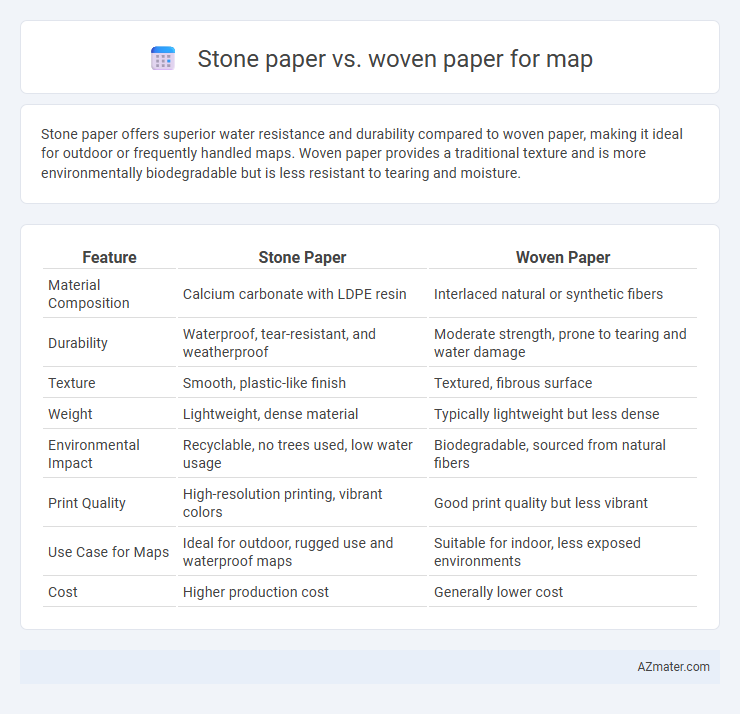Stone paper offers superior water resistance and durability compared to woven paper, making it ideal for outdoor or frequently handled maps. Woven paper provides a traditional texture and is more environmentally biodegradable but is less resistant to tearing and moisture.
Table of Comparison
| Feature | Stone Paper | Woven Paper |
|---|---|---|
| Material Composition | Calcium carbonate with LDPE resin | Interlaced natural or synthetic fibers |
| Durability | Waterproof, tear-resistant, and weatherproof | Moderate strength, prone to tearing and water damage |
| Texture | Smooth, plastic-like finish | Textured, fibrous surface |
| Weight | Lightweight, dense material | Typically lightweight but less dense |
| Environmental Impact | Recyclable, no trees used, low water usage | Biodegradable, sourced from natural fibers |
| Print Quality | High-resolution printing, vibrant colors | Good print quality but less vibrant |
| Use Case for Maps | Ideal for outdoor, rugged use and waterproof maps | Suitable for indoor, less exposed environments |
| Cost | Higher production cost | Generally lower cost |
Introduction to Stone Paper and Woven Paper
Stone paper is a durable, eco-friendly material made from calcium carbonate bonded with non-toxic resin, offering water resistance and tear-proof qualities ideal for map printing. Woven paper, composed of interlaced fibers, provides flexibility and a textured surface but lacks the waterproof and tear-resistant properties of stone paper. Both materials serve different functional needs, with stone paper excelling in longevity and environmental sustainability for outdoor map use.
Composition and Manufacturing Processes
Stone paper is composed primarily of calcium carbonate bonded with non-toxic resin, offering a waterproof and tear-resistant alternative to traditional fibers. Woven paper is made from interlaced cellulose fibers derived from wood pulp, providing flexibility but susceptibility to moisture damage. Manufacturing stone paper involves pulverizing limestone and mixing it with resin under heat to form sheets, whereas woven paper production includes pulping, pressing, and drying fiber mats into thin sheets.
Environmental Impact and Sustainability
Stone paper, made from calcium carbonate and non-toxic resins, offers a sustainable alternative to traditional woven paper by reducing deforestation and water consumption during production. Its durability and water resistance extend the lifespan of maps, minimizing waste compared to woven paper, which relies on cellulose fiber from trees and involves significant chemical processing. The biodegradable and recyclable properties of stone paper further enhance its environmental benefits, making it a greener choice for map printing.
Durability and Tear Resistance
Stone paper offers superior durability and tear resistance compared to woven paper, making it highly suitable for maps exposed to harsh environmental conditions. Its synthetic composition provides waterproof and tear-proof properties, ensuring longevity even under frequent handling. In contrast, woven paper, though strong, is more prone to wear and damage from moisture and rough use, reducing its effectiveness for long-term map applications.
Water Resistance and Weatherproof Qualities
Stone paper exhibits superior water resistance due to its non-porous, mineral-based composition, making it highly durable for maps exposed to rain or humidity. Woven paper, while providing enhanced strength from interlaced fibers, tends to absorb water, which can compromise map legibility and lifespan in wet conditions. For weatherproof qualities, stone paper offers better resistance against UV rays and moisture, maintaining its integrity and print quality during outdoor use.
Print Quality and Color Vibrancy
Stone paper delivers exceptional print quality with sharp detail and smooth textures, making it ideal for high-resolution maps. Its non-porous surface enhances color vibrancy by preventing ink absorption, resulting in richer and more vivid hues compared to traditional woven paper. Woven paper, while offering decent print clarity, tends to absorb ink unevenly, leading to less saturated colors and potential fading over time.
Weight, Texture, and Handling
Stone paper offers a lightweight alternative to woven paper for maps, enhancing portability without sacrificing durability. Its smooth, non-porous texture resists tearing and water damage, making it ideal for outdoor use and repeated folding. Woven paper provides a traditional tactile feel with a coarser surface, which may be preferred for detailed tactile navigation but tends to be heavier and less resistant to environmental wear.
Cost Comparison and Availability
Stone paper is generally more expensive than woven paper due to its unique manufacturing process using calcium carbonate and resin, which also enhances durability and water resistance for maps. Woven paper, made from interlaced fibers like cotton or synthetic materials, tends to be more affordable and widely available, making it a cost-effective choice for large-scale map printing. Availability of woven paper is extensive across global suppliers, whereas stone paper remains less common and may require specialized sourcing, potentially increasing lead times and overall costs.
Best Use Cases for Maps
Stone paper offers exceptional water resistance and durability, making it ideal for outdoor maps used in hiking, camping, and marine navigation where exposure to moisture is common. Woven paper, with its flexible yet sturdy weave, is better suited for high-detail, foldable urban and transit maps requiring frequent handling and precise print clarity. Selecting stone paper enhances longevity in harsh environments, while woven paper optimizes map readability and portability in everyday scenarios.
Conclusion: Choosing the Right Paper for Your Map
Stone paper offers superior durability, water resistance, and tear resistance, making it ideal for outdoor or frequently handled maps. Woven paper provides a traditional texture and better ink absorption, suitable for indoor use or decorative purposes. Selecting the right paper depends on the map's intended environment and usage frequency, with stone paper favored for rugged conditions and woven paper preferred for aesthetic quality.

Infographic: Stone paper vs Woven paper for Map
 azmater.com
azmater.com